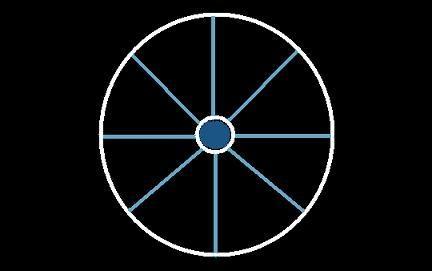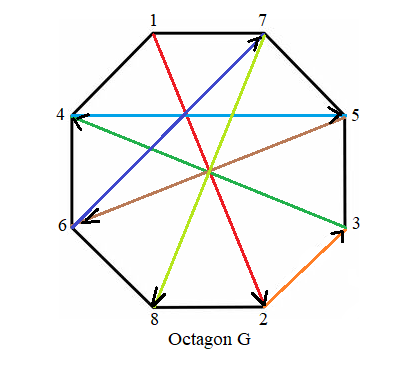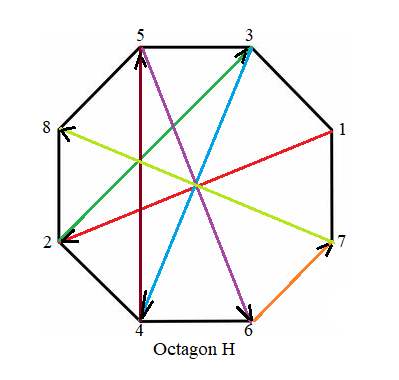Octagon Algorithm for Border Wheel Squares (Part VII)
The Eight Node Way - 7×7 Squares
The previous section Part V introduced the Octagon E and F algorithm for the construction of 7×7 Wheel Squares. The main diagonal of the wheel structure was filled in in reverse order (22,23,22,25,28,27,26) in order to produce the new border squares. This section will depict the Wheel Border where the main diagonal is in regular order but the rows and columns of the wheel are constructed so that the difference (Δ) between each term is 3, 5, 7 or 9 units. These Δ values are important in that they allow us to construct different wheel structures in the square as long as there are enough numbers in the complement table to construct a wheel.
If not, then there is a maximum number of wheel structures allowed for a particular order n. It will be shown that the number of wheel structures decreases as Δ increases. For instance, for n=7 when Δ = 3, 5, 7 and 9 the number of consecutive border squares that can be constructed is 7, 5, 3 and 1, respectively. A table for these values can be found in Part VIII. When Δ values are greater than 7 it is not possible to construct border squares due to an insufficient number of terms in the complement table. Thus, the maximum value that Δ can take is n + 2 for consecutive spoke numbers chosen from the complementary table. A total of four squares each with the above Δ values will be shown below for the two different Octagonal algorithms. All the squares will be of the same type, i.e., each will start with the initial number 1 in the top center column and again will vary according to the Δ value.
To start, the wheel part of the square is first constructed using either of the three (Δ) values followed by the non wheel portion (i.e, non spokes) which uses either the Octagon G or H algorithm to fill in the empty cells. The method can be summarized as follows where regular means with a degree of separation (Δ) between numbers:
a) the main diagonal is first filled in with the numbers 22,23,24,25,26,27,28
b) the central column is filled in regular order starting at the topmost cell and moving to the bottom cell
c) the left diagonal is filled in regular order starting at the right bottom cell and moving to the leftmost top cell
d) the central row is filled in regular order starting at the leftmost cell and moving to the rightmost cell
In addition, both the Wheel and Octagon algorithms use the following 7×7 complementary table as a guide for picking the 25 wheel spoke numbers and the 24 non spoke numbers:
| 1 | 2 | 3 | 4 | 5 | 6 | 7 | 8 | 9 | 10 |
11 | 12 | 13 | 14 | 15 | 16 | 17 | 18 | 19 | 20 | 21 |
22 | 23 | 24 |
|
|
| 25 |
| 49 | 48 | 47 | 46 | 45 | 44 | 43 | 42 | 41 | 40 | 39 |
38 | 37 | 36 | 35 | 34 | 33 | 32 | 31 | 30 | 29 |
28 | 27 | 26 |
|
The first algorithm employed, Octagon G, is depicted with the initial node at the top left of the octagon:
We start by adding the lowest spoke number on the complementary table to position (1,0), i.e., position (row, column), on the square. For instance, in Border 7(03)g the first non spoke number, 10, goes into the cell corresponding to node 1. In addition, employing Octagon G one follows the arrows and deposits a number into the appropriate white cell of the square to generate the following four squares:
Border 7(03)g
| 48 | 10 |
14 | 1 |
35 | 39 | 28 |
| 13 | 45 |
18 | 4 |
31 | 27 | 37 |
| 17 | 21 |
42 | 7 |
26 | 29 | 33 |
| 3 | 6 |
9 | 25 |
41 | 44 |
47 |
| 34 | 30 |
24 | 43 |
8 | 20 | 16 |
| 38 | 23 |
32 | 46 |
19 | 5 | 12 |
| 22 | 40 |
36 | 49 |
15 | 11 | 2 |
|
|
Border 7(05)g
| 48 | 4 |
14 | 1 |
35 | 45 | 28 |
| 10 | 43 |
18 | 6 |
31 | 27 | 40 |
| 17 | 21 |
38 | 11 |
26 | 29 | 33 |
| 3 | 8 |
13 | 25 |
37 | 42 |
47 |
| 34 | 30 |
24 | 39 |
12 | 20 | 16 |
| 41 | 23 |
32 | 44 |
19 | 7 | 9 |
| 22 | 46 |
36 | 49 |
15 | 5 | 2 |
|
Border 7(07)g
| 48 | 4 |
11 | 1 |
38 | 45 | 28 |
| 7 | 41 |
18 | 8 |
31 | 27 | 43 |
| 14 | 21 |
34 | 15 |
26 | 29 | 36 |
| 3 | 10 |
17 | 25 |
33 | 40 |
47 |
| 37 | 30 |
24 | 35 |
16 | 20 | 13 |
| 44 | 23 |
32 | 42 |
19 | 9 | 6 |
| 22 | 46 |
39 | 49 |
12 | 5 | 2 |
|
|
Border 7(09)g
| 48 | 4 |
8 | 1 |
41 | 45 | 28 |
| 7 | 39 |
15 | 10 |
34 | 27 | 43 |
| 14 | 18 |
30 | 19 |
26 | 32 | 36 |
| 3 | 12 |
21 | 25 |
29 | 38 |
47 |
| 37 | 33 |
24 | 31 |
20 | 17 | 13 |
| 44 | 23 |
35 | 40 |
16 | 11 | 6 |
| 22 | 46 |
42 | 49 |
9 | 5 | 2 |
|
where the numbering, for example, 7(03)g correponds to n=7, 0 is the wheel type, 3 is the Δ and g is the algorithm used in this case Octagon G. In the second algorithm, Octagon H, with node 1 is located at the middle right of the octagon is employed to construct the second series of 7×7 border squares.
The second series, although having the same identical wheel structures as the four squares above, vary according to the placement of the non spoke numbers.
Border 7(03)h
| 48 | 37 |
33 | 1 |
16 | 12 | 28 |
| 40 | 45 |
29 | 4 |
20 | 27 | 10 |
| 36 | 32 |
42 | 7 |
26 | 18 | 14 |
| 3 | 6 |
9 | 25 |
41 | 44 |
47 |
| 15 | 19 |
24 | 43 |
8 | 31 | 35 |
| 11 | 23 |
21 | 46 |
30 | 5 | 39 |
| 22 | 13 |
17 | 49 |
34 | 38 | 2 |
|
|
Border 7(05)h
| 48 | 40 |
33 | 1 |
16 | 9 | 28 |
| 46 | 43 |
29 | 6 |
20 | 27 | 4 |
| 36 | 32 |
38 | 11 |
26 | 18 | 14 |
| 3 | 8 |
13 | 25 |
37 | 42 |
47 |
| 15 | 19 |
24 | 39 |
12 | 31 | 35 |
| 5 | 23 |
21 | 44 |
30 | 7 | 45 |
| 22 | 10 |
17 | 49 |
34 | 41 | 2 |
|
Border 7(07)h
| 48 | 43 |
36 | 1 |
13 | 6 | 28 |
| 46 | 41 |
29 | 8 |
20 | 27 | 4 |
| 39 | 32 |
34 | 15 |
26 | 18 | 11 |
| 3 | 10 |
17 | 25 |
33 | 40 |
47 |
| 12 | 19 |
24 | 35 |
16 | 31 | 38 |
| 5 | 23 |
21 | 42 |
30 | 9 | 45 |
| 22 | 7 |
14 | 49 |
37 | 44 | 2 |
|
|
Border 7(09)h
| 48 | 43 |
36 | 1 |
13 | 6 | 28 |
| 46 | 39 |
32 | 10 |
17 | 27 | 4 |
| 42 | 35 |
30 | 19 |
26 | 15 | 8 |
| 3 | 12 |
21 | 25 |
29 | 38 |
47 |
| 9 | 16 |
24 | 31 |
20 | 34 | 41 |
| 5 | 23 |
18 | 40 |
33 | 11 | 45 |
| 22 | 7 |
14 | 49 |
37 | 44 | 2 |
|
This completes the Octagon G and H method for 7×7 squares. Go to Part IX for (a,b,e) squares. Go to Part VIIIa or
to go back to Part VI. Go back to homepage.
Copyright © 2022 by Eddie N Gutierrez. E-Mail: enaguti1949@gmail.com



